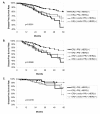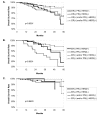Triple negative breast carcinoma is a prognostic factor in Taiwanese women
- PMID: 19534825
- PMCID: PMC2706258
- DOI: 10.1186/1471-2407-9-192
Triple negative breast carcinoma is a prognostic factor in Taiwanese women
Abstract
Background: Currently, there is a debate as to whether triple negative breast carcinoma (TNBC) has a worse prognosis than non-TNBC. Our aim was to determine whether TNBC is a prognostic factor for survival.
Methods: We identified 1,048 Taiwanese breast carcinoma patients, of whom 167 (15.9%) had TNBC. Data used for analysis were derived from our cancer registry database for women with breast cancer who were diagnosed between 2002 January and 2006 December.
Results: In the Kaplan-Meier analysis, tumor subgroup (TNBC vs. non-TNBC) was a prognosis factor related to 5-year overall survival. In the univariate analysis, tumor subgroup (TNBC vs. non-TNBC) was a significant factor related to 5-year overall survival, in addition to age, tumor size, lymph node, metastasis, grade, stage, estrogen receptor status, progesterone receptor status, and HER2 overexpression status. In the multivariate analysis, tumor subgroup was not a significant factor related to 5-year disease-free survival (DFS). In node-positive patients, tumor subgroup was a significant factor related to 5-year overall survival, in addition to age, tumor size, metastasis, and grade. In node-negative patients, tumor subgroup was not a significant factor related to 5-year disease-free survival and 5-year overall survival.
Conclusion: Our results indicated that TNBC patients in Taiwan have worse 5-year overall survival than non-TNBC patients. Notably, in node-positive patients, TNBC played a prognostic role in 5-year overall survival.
Figures



References
-
- Alexe G, Dalgin GS, Scanfeld D, Tamayo P, Mesirov JP, Ganesan S, Delisi C, Bhanot G. Breast cancer stratification from analysis of micro-array data of micro-dissected specimens. Genome Inform. 2007;18:130–140. - PubMed
-
- Liedtke C, Mazouni C, Hess KR, Andre F, Tordai A, Mejia JA, Symmans WF, Gonzalez-Angulo AM, Hennessy B, Green M. Response to neoadjuvant therapy and long-term survival in patients with triple-negative breast cancer. J Clin Oncol. 2008;26:1275–1281. - PubMed
-
- Yin WJ, Lu JS, Di GH, Lin YP, Zhou LH, Liu GY, Wu J, Shen KW, Han QX, Shen ZZ, Shao ZM. Clinicopathological features of the triple-negative tumors in Chinese breast cancer patients. Breast Cancer Res Treat. 2009;115(2):325–33. - PubMed
-
- Cheang MC, Voduc D, Bajdik C, Leung S, McKinney S, Chia SK, Perou CM, Nielsen TO. Basal-like breast cancer defined by five biomarkers has superior prognostic value than triple-negative phenotype. Clin Cancer Res. 2008;14:1368–1376. - PubMed
MeSH terms
Substances
LinkOut - more resources
Full Text Sources
Medical
Research Materials
Miscellaneous

